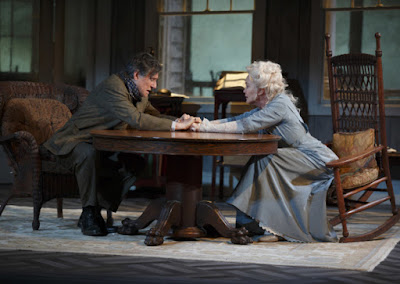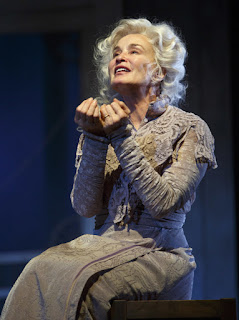The Emotional Physicality of "Long Day's Journey Into Night"
We had the great pleasure of seeing the new production of Eugene O'Neill's "Long Day's Journey Into Night" in New York last weekend. It starred the accomplished actors Gabriel Byrne and Jessica Lange as James and Mary Tyrone, the parents of the tortured family of four whose fraught relationships are tracked across four acts that take them from morning to midnight. The older son, Jamie, is played with lacerating intensity by Michael Shannon. The other son, Edmund, who leans toward poetry and romantic despair, is played by John Gallagher, Jr. The director is Jonathan Kent.
We don't go to see much theater, so it ended up being quite an eye-opening evening for me. I almost said life changing, but I don't think I'll run away to join a theater troupe anytime soon, so I'll not get carried away here. What is true is that I learned some things about theater's unique power that night -- things that theater lovers already know, but which really jumped out at me.
The first had to do with the raw physicality of the play, the sense of power and emotion communicated by the positioning of bodies and how the actors used their bodies as instruments. I have never gotten the same sense from a movie or television show -- even the really good ones. Not even close. Our seats were in the balcony of the small theater, so we looked down on the stage, which depicted the "great room" of the family's coastal home. In the center of the room stood a table and two chairs, and on the table rested a bottle of whiskey that occupied the space like a tragic totem. Always the whiskey. Few scenes took place without some contact with it. It was their sacrament and their poison.
By looking down we could see the choreography of the actor's movements. They came together and apart in a constant dance, as if propelled by a force field that alternately attracted them to and repelled them from one another. The sensitive son, Edmund, spent most of the play pinned to the far wall beneath the stairs, clinging to a book and with his body turned sideways. Whenever James was in the room he occupied the chair to the left of the table and others would take turns joining him for more arguments or exercises in denial, interrupted by very fleeting moments of affection and empathy. When he was gone, the others took turns in the chairs, performing a variety of duets. Mary spent most of her time either floating up and down the stairs or around the room or sitting on a stool as far from the table as possible. In the final act, Jamie comes home smashed from a night of boozing and whoring, and his presence here was explosive and dangerous like a wrecking ball. Of all the actors, Michal Shannon defined his character through his body. And I don't mean through a series of tics, like Dustin Hoffman in Rain Man. I mean through the menacing energy that came of him in waves. It would be fascinating to watch these movements without words, as if it were pure dance. Again, I don't know a lot about theater, but I guess that a lot of time is spent in rehearsal on getting the choreography right. I think that a great deal of the movement was up to the director's discretion. The scenes at the table are probably scripted; in other words those scenes have to take place at the table.
The play revolves around Mary's morphine addiction and Edmund's life-threatening disease of "consumption." The fog that rolls in and out of the bay serves as metaphor both for Mary's addiction and the fog of denial that the family members mostly walk around in. Throughout the play the characters would swing back and forth between affection and hatred for one another. This seemed to me like the waves that wash up on the shore and then recede in a never-ending pattern. My friend said the emotions were like the swans that continually enter and exit the stage in Swan Lake. Did the characters repeat themselves? Yes, they did. But so do we, don't we? And each time the characters would bring up the old allegations and resentments and justifications the scenes would have new dimensions to them, just like the repetition of motifs in musical composition.
Creating such a powerful and seamless rendition of a play such as "Long Day's Journey," so intricate and long and wrenching, must take a huge amount of effort and commitment. Byrne and Lange likely don't need the money, so it must be that theater means a lot to them as actors. In fact, I would guess it means everything to them.



Comments
Post a Comment